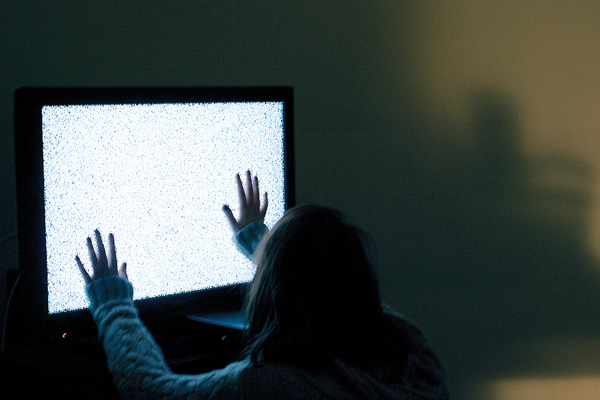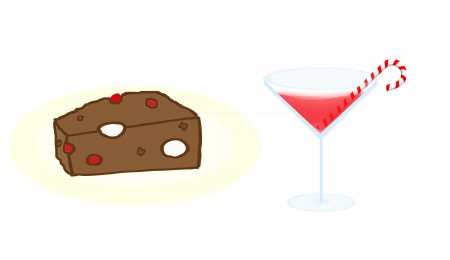Why do so many people get their kicks from scary flicks?
Photo by Tina Wallace
Every year throughout the month of October, it seems like cable TV programming wants to give me a heart attack. While flipping through the channels I basically have the choice to watch news or Barney because most of the good channels are playing some sort of horror movie marathon.
When I was younger, I would sit through hours and hours of horror movies, pretending to laugh and enjoy myself while secretly closing my eyes when the film got really scary. Now I wear my disdain for horror movies on my sleeve and make a loud and proud protest about not watching them when my braver friends are begging to throw one in the DVD player.
I’ve decided it’s time to try to understand what all the fuss is about when it comes to horror movies and why babies like me will never enjoy them.
It’s a craving
A few weeks ago, I went to the movie theatre to see the second Insidious movie. As per usual, I didn’t watch much of it, and while I stared at my boyfriend, simply because there was nowhere else to look, I noticed his twitching and jumping and just couldn’t understand why he enjoys feeling like that.
Recent University of Ottawa visual arts graduate Ali Collins Ste-Croix says she thinks horror movies are a way for people to forget about the other things they’re afraid of.
“I think apart from the adrenaline rush and overall excitement of it, feeling scared during a horror movie can serve as a great distraction from daily fears,” she said.
It makes sense. Stories in the news and within our friend groups are scary because they’re real. In comparison to thinking about those terrors before we go to bed, thinking about a ghoul or monster that isn’t real is probably quite comforting.
U of O fiction of horror professor Sean Moreland agrees that the adrenaline rush people get from feeling fear without feeling threatened in real life is a large selling point of horror movies.
“Another is the less immediate pleasure of being unsettled, having a film leave you with a lot of questions, a new (and often uncomfortable) awareness, a lasting sense of having brushed against something strange and difficult to describe,” he said.
Alexandra Petruck, a former film student at New York University, recently worked as a costume designer on the set of Scarehouse, an upcoming horror movie. She said she loves the squirmy and uncomfortable feeling she gets in her seat when scary and gory scenes are unfolding in front of her.
“It’s also kind of priding to say you’ve seen and could sit through certain scary films,” she said.
I understand this sentiment. When I was younger and watched horror movies with my friends it was definitely to impress them. I liked feeling as though I had accomplished some kind of incredible feat because I could sit through a loud and terrifying movie.
They keep us awake
After forcing myself to watch these flicks, I’d lay awake in bed every night tossing and turning, relentlessly trying to erase the horrific images from my memory. It never worked, and I still get scared of monsters from movies I watched years and years ago.
Research from Joanne Cantor, the outreach director of the Center for Communication Research at the University of Wisconsin-Madison, suggests horror movies generally keep many people scared long after they’ve seen horrific images.
She and other researchers conducted an experiment in 1999 in which information was gathered about memories of some college students’ most extreme reactions to horror media. Out of 91 answers, 46 per cent of the students discussed their specific film’s effect on their bedtime behaviour, while 75 per cent said the movie affected the viewers’ waking lives.
“These findings reveal that scary movies have an overwhelming tendency to stay with the viewer for a long time, long after the viewer understands that the lingering response is to some extent irrational,” wrote Cantor.
She says that even though we know a specific killer never lived and that murders we witness in a horror flick never took place, the story vividly reminds us of real threats that do exist in the world around us.
Though many people take solace in the fact that fictional horror can transport them away from real horrors, realistic fiction leads us to believe that a movie or story is based on something that actually happened to someone. The details have likely been changed, but because of the way real people are integrated with less than realistic events, realistic fiction is highly plausible and can therefore profoundly affect the way we see and respond to our own world.
Horror blogger and scary movie enthusiast Carley Smith said she generally receives positive feedback from the viewers of her blog and is pleasantly surprised by their responses. From her experience, many people view horror blogs negatively because they believe the images are real.
“The amount of people who can mistake a fake scene in a movie for something real is astonishing,” she said.
The psychology of horror
The reason why we react to certain aspects of horror movies after watching them is a result of fear conditioning.
In her research, Cantor describes a theory proposed by neural scientist Joseph LeDoux that explains why people can have adverse reactions to unusual stimuli long after they’ve experienced something traumatic.
The hippocampus, the region in our brains that appraises and makes sense of situations, and the amygdala, where subconscious emotional memories are mediated, are both parts of our brain that could be what keep our fears present long after we watch a horror movie. While the hippocampus helps us work through a situation logically, the amygdala sparks a quick response that gives us the general reactions we have to scary situations like sweaty palms, increased heart rate, and tensed muscles.
“If a man has a serious, traumatic automobile accident during which the horn of his car gets stuck on, he is likely to experience bodily reactions associated with fear in future situations when hearing the sound of a horn,” she wrote. “The horn may, in fact, remind him of the accident, and he may consciously associate his feelings with that event [or] he may forget about the association of the horn with the accident but still have physiological responses associated with fear whenever he hears a horn sound.”
To attribute this effect to horror movies, Cantor uses the example of Jaws. When the viewers she surveyed felt intense fear while watching Jaws, their implicit fear reactions, spurred by their amygdalas, became conditioned to a combination of the stimuli in the movie (the image of the shark or swimming in water, for example). Experiencing any of the stimuli in the movie outside of the film will most likely trigger physical reactions for the viewers in the future.
She also uses the movie Poltergeist as an example—a movie that did a number on me when I saw it. Many of the students in the study that listed Poltergeist as the horror film that most prominently affected them experienced fear conditioning to images of clowns, tree branches outside windows, fuzzy television sets, and other scary situations in the movie.
Though white noise on a television set poses no real threat logically, I freak out whenever I see it because it will likely be forever associated with the state of panic I was in while watching Poltergeist.
Will I always be afraid of horror movies?
When I was younger, I figured I might outgrow my fear of scary movies. Alas, I still get squeamish and incredibly uncomfortable when I’m faced with a horror film.
Though she has yet to watch a horror flick since the production of Scarehouse wrapped, Petruck believes learning how a scary movie is made first-hand will take the edge off a bit when she watches them in the future.
“While working on set and seeing the whole process of goring someone up, I felt that after that, I’d totally be able to take on any horrific challenge,” she said. “All past horror films have definitely sent their fair share of shivers down my spine—a feeling I may just miss.”
Working on the set of a horror movie is one way to become desensitized to scary images and plot lines. Both Moreland and Smith agree they’re rarely scared by these movies.
“Not very often do I feel fear while watching a horror film,” said Moreland.
Although he did get some good “jump-scares” from the movies Rec and The Strangers and sometimes feels “unsettled”during movies like Inland Empire and Martyrs.
After watching scary movies for many years, Smith has become much less horrified while watching them in the present.
“After watching so many horror movies—the number over 500—I’ve grown so accustomed to the genre that I can almost no longer be shocked or scared anymore,” she said. “Instead of fear, I have admiration for story line, characters, use of lighting, special effects and even soundtracks.”
Maybe one day, if I can start watching horror movies with my eyes at least half open, I’ll be able to appreciate these films for the values that accompany them other than their scare tactics, like the cinematography or the “feeling of confusion” Collins Ste-Croix says she experiences while watching psychological horror movies.
Until then, I think I’ll stick to watching Rom-Coms and feel-good family flicks when I’m alone in a dark room.





